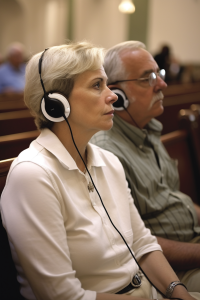8 Ways to Be a more inclusive church
Introduction
The blog provides 8 ways to be a more inclusive church, as I’ve encountered many churches that don’t cater for people with disabilities (PWD). I use a wheelchair, and a few churches either don’t have a suitable bathroom or don’t allow me to enter their church.
1. Assistive Listening Devices
 Assistive Listening Devices (ALDs) are crucial in establishing churches as welcoming and inclusive spaces for individuals with hearing impairments. These devices enable people who are hard of hearing or deaf to perceive sounds with enhanced clarity and amplify them to a comfortable volume. ALDs can be employed in various settings, such as sermons, choirs, and musical performances, ensuring everyone can actively participate and relish the experience.
Assistive Listening Devices (ALDs) are crucial in establishing churches as welcoming and inclusive spaces for individuals with hearing impairments. These devices enable people who are hard of hearing or deaf to perceive sounds with enhanced clarity and amplify them to a comfortable volume. ALDs can be employed in various settings, such as sermons, choirs, and musical performances, ensuring everyone can actively participate and relish the experience.
The inability to hear during a service can result in feelings of disconnection, potentially leading to isolation and frustration. It is essential to recognise that ALDs cater not only to the elderly, as hearing challenges can impact individuals across all age groups. By making this technology available, churches cultivate an atmosphere that embraces people from diverse age groups, backgrounds, and abilities, thus fostering a truly inclusive and supportive community.
2. Large Print and Braille Materials
Large Print and Braille Materials are critical components of an inclusive church. These materials help individuals with visual impairments access printed materials such as hymnals, bulletins, and study materials. By providing large print or braille materials, churches can ensure that everyone can fully participate in the service and access the necessary information.
3. Sensory-Friendly Spaces for a more inclusive church
Sensory-Adaptive Environments are designed to accommodate individuals with sensory processing challenges, such as autism, ensuring their comfort and integration within the church community. These environments are crafted to mitigate sensory overstimulation, which can be daunting for people with sensory processing difficulties, and to alleviate stress and anxiety, thus enabling them to engage wholeheartedly in services and activities.
Establishing a sensory-adaptive environment entails considering various aspects, including illumination, acoustics, and spatial arrangement. For instance, subdued lighting minimises sensory overstimulation, while gentle music imparts a soothing ambience. Sensory-adaptive spaces may also incorporate sensory aids such as weighted blankets, fidget gadgets, and noise-reduction headphones, which can assist individuals in managing sensory overstimulation.
4. Visual Aids and Captioning
Visual aids and captioning are crucial for ensuring all congregation members can fully participate in church activities.
Visual aids can include anything from PowerPoint presentations to handouts or posters. They help to enhance the message being conveyed and provide an additional way for people to understand and remember the content. Captioning, on the other hand, involves providing text descriptions of spoken words, making it possible for people with hearing impairments to follow along.
Well-placed signs that can be easily read by everyone will help visitors find their way around the church.
5. Adaptive Programs
Tailored initiatives are devised to cater to the needs of individuals with disabilities, enabling their full involvement in church activities. These measures can encompass various adaptations, such as customised seating arrangements, adaptive equipment, wheelchair ramps, and customized programs for individuals with disabilities.
For instance, a tailored initiative might comprise a Sunday school curriculum designed for children with disabilities, ensuring their engagement in church activities alongside their peers.
6. Sign Language Interpreters will deliver a more inclusive church
 Sign language interpreters are an important resource for individuals who are deaf or hard of hearing. They help ensure that everyone can fully participate in church activities by providing communication accessible to all.
Sign language interpreters are an important resource for individuals who are deaf or hard of hearing. They help ensure that everyone can fully participate in church activities by providing communication accessible to all.
Having a sign language interpreter available during church services or events is crucial for ensuring that individuals who are deaf or hard of hearing can fully participate in all activities. It creates a more inclusive environment and helps promote understanding and acceptance among all congregation members.
7. Accessible Online Presence
In today’s digital age, having an accessible online presence is crucial for any organisation, including churches. This means ensuring that all website visitors, including those with disabilities or limited access to technology, can easily access and engage with the church’s website and online resources.
One way to make online resources more accessible is to provide alternative text descriptions for images and videos. This can help individuals with visual impairments to understand the content of the image or video, even if they cannot see it. Additionally, ensuring that website layouts and fonts are easy to read can make it easier for individuals with cognitive or learning disabilities to access online content.
8. Inclusive Leadership will result in a more inclusive church
Inclusive leadership is crucial to creating a welcoming and inclusive church community. This means ensuring all church members feel valued, respected, and included in decision-making.
One way to foster inclusive leadership is to create a diverse team of individuals with different backgrounds, experiences, and perspectives. This can help to ensure that all members of the church community are represented and that decisions are made with a wide range of perspectives in mind.
Another important aspect of inclusive leadership is ensuring that church community members can participate in leadership roles. This means providing training and support to individuals without previous leadership experience and actively encouraging participation from underrepresented groups.
Read more about this site.
More information about me is found at johnduthie.com
